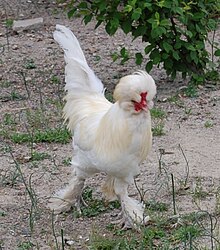Sultan chicken
 | |
| Conservation status | Study |
|---|---|
| Other names | Serai-Tavuk, Serai-Täook |
| Country of origin | Turkey |
| Use | Ornamental |
| Traits | |
| Weight |
|
| Egg color | White |
| Comb type | Duplex |
| Classification | |
The Sultan is a breed of chicken originating in Turkey, belonging to the group of crested chicken. Its English moniker is directly culled from the original Turkish language name of Serai-Tavuk, which translates as "fowls of the Sultan".[1] They have always been primarily ornamental, having been kept in the gardens of Ottoman sultanate.[1] In the West they are bred for competitive showing as part of poultry fancy, and are generally a rare sight.[2]
The breed was first exported from its native country in 1854, when a Ms. Elizabeth Watts of Hampstead, London brought a small flock to Britain.[2] It was seen in North America by 1867, and was recognized officially by acceptance into the American Poultry Association's Standard of Perfection in 1874.[1]
Sultans have a great deal of decorative plumage, including large, puffy crests, beards, long tails, and profuse foot feathering. Their small, V-shaped combs are almost entirely hidden under feathering. Sultans are also one of a minority of breeds to have five toes on each foot.[2] With males weighing approximately 2.7 kilos (6 pounds) and hens 2 kilos (4 pounds), they are the smallest of the large breeds of chickens. They also have a bantam version.
Sultans appear in three varieties: Black, Blue, and White,[3] with White being the most well known.[4] Hens lay small white eggs at a slow rate, and do not generally go broody. In temperament, Sultans are quite docile, friendly chickens, and are content at being kept in confinement. Most Sultan breeders take care to raise them in dry bedding in order to protect their elaborate feathering, especially on the feet. They may also be bullied somewhat if kept in flocks with more active breeds.
See also[]
Footnotes[]
- ^ a b c (Ekarius 2007, p. 159)
- ^ a b c (Graham 2006, p. 173)
- ^ (Ekarius 2007, p. 160)
- ^ (Heinrichs 2007, p. 65)
References[]
- Ekarius, Carol (2007). Storey's Illustrated Guide to Poultry Breeds. 210 MAS MoCA Way, North Adams MA 01247: Storey Publishing. ISBN 978-1-58017-667-5.CS1 maint: location (link)
- Graham, Chris (2006). Choosing and Keeping Chickens. 2-4 Heron Quays London E14 4JP: Octopus Publishing. ISBN 978-0-7938-0601-0.CS1 maint: location (link)
- Heinrichs, Christine (2007). How To Raise Chickens. Voyageur Press. ISBN 978-0-7938-0601-0.
External links[]
- Sultan's at mypetchicken
 Media related to Sultan (chicken) at Wikimedia Commons
Media related to Sultan (chicken) at Wikimedia Commons
- Chicken breeds
- Chicken breeds originating in Turkey
- Animal breeds on the RBST Watchlist
- Poultry stubs